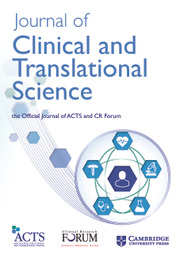No CrossRef data available.
Article contents
585 An input-mechanism-outcome model to support integration of community health workers in primary care
Published online by Cambridge University Press: 11 April 2025
Abstract
Objectives/Goals: Community health workers (CHWs) are links between the community and healthcare. As primary care (PC) expands to address social drivers of health, CHWs are becoming part of PC teams, yet how the two integrate is not well understood. Using an input-mechanism-outcome (IMO) model, this research seeks to develop a model to expand CHW-PC integration efforts. Methods/Study Population: Participants were recruited from Roots Community Health Center (Roots), a CHC serving historically marginalized communities, that has successfully integrated a CHW role, Roots Health Navigators (RHNs), into PC services. The preliminary conceptual framework for this study was guided by an overarching IMO model and informed by social identity theory, team science, and the interprofessional care literature. A mixed methods study was conducted in three phases: 1) cross-sectional survey, 2) semi-structured interviews, and 3) model development. The survey identified team dynamics such as communication, trust, and shared understanding, and interviews explored how these collaborative teaming mechanisms take shape. Findings were merged into a final model of CHW-PC integration that was reviewed by Roots leaders. Results/Anticipated Results: Survey results (n = 25) highlighted highly rated team dynamics including shared understanding and acting and feeling like a team. Qualitative findings (n = 10) described how integration occurred through complex interactions that were community-responsive and collectively reduced burnout among the team. Joint findings noted the importance of RHNs to continuity of care, building trust, and enhancing PC team effectiveness. Findings informed the development of a model of CHW-PC integration. This expanded on the preliminary conceptual framework by highlighting the dynamic relationship between mechanisms, processes, and team emergent states, as well as providing evidence to support feedback loops between inputs, mechanisms, and outcomes with overarching influence from the contextual setting. Discussion/Significance of Impact: With a deeper understanding of the mechanisms of CHW-PC integration, findings informed the development of a model that can support other communities to replicate this approach to care and address critical patient needs. Teaming factors that sustain CHW-PC integration may be transferrable to other care teams integrating nontraditional roles.
Information
- Type
- Team Science
- Information
- Creative Commons
- This is an Open Access article, distributed under the terms of the Creative Commons Attribution-NonCommercial-NoDerivatives licence (https://creativecommons.org/licenses/by-nc-nd/4.0/), which permits non-commercial re-use, distribution, and reproduction in any medium, provided the original work is unaltered and is properly cited. The written permission of Cambridge University Press must be obtained for commercial re-use or in order to create a derivative work.
- Copyright
- © The Author(s), 2025. The Association for Clinical and Translational Science

